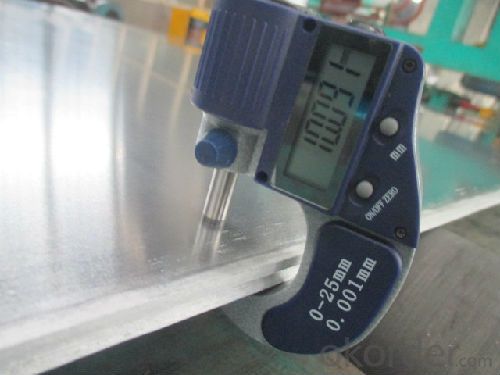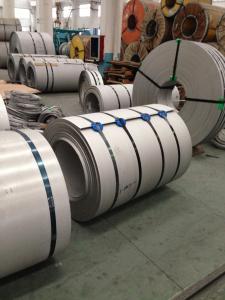Stainless Steel Plate Cold Rolled And Hot Rolled Stocks
- Loading Port:
- Guangzhou
- Payment Terms:
- TT or LC
- Min Order Qty:
- 2 m.t.
- Supply Capability:
- 5000 m.t./month
OKorder Service Pledge
OKorder Financial Service
You Might Also Like
1.Structure of Product Description
Cold rolled AND HOT ROLLED aluminum sheet is widely used in the field of construction field and decoration field, etc.
There are many different grades, such as: 1000 series, 2000 series, 3000 series, 5052,5754,5083,6061,6063,8011, etc.
The temper is include H14, H22, H24, H44,H112,H114,etc.
2. Main features of the product
a.Competitive price
b.Frist-Class Service.
c. Shortest service.
3. Image.


4. Product detailed sizes:
1000mm*2000mm, 1219mm*2438mm,1220mm*2440mm, 1250mm*2500mm,1500mm*3000mm, etc.
5. FAQ:
What is the quality standard?
---Usually our standard is GB3880-2006 or others.
What is the width range?
---It is from 1000mm to 2500mm, etc.
---Normally it is around 9000 tons totally.
Where is your client from?
---Normally it is from Japan, USA, ENGLISH, BANGLADESH, SRI LANKA, VIETNAM,
INDONEVISA, ETC.
SINGAPORE, ETC.
What is your mainly products?
---Normally they are aluminum sheet, checkered sheet, SS SHEET,PPGI,GI.
mirror finish aluminium sheet, aluminum casting coil, etc.
- Q:How do you prevent chloride-induced corrosion in stainless steel sheets?
- One effective way to prevent chloride-induced corrosion in stainless steel sheets is by ensuring proper maintenance and cleaning. Regularly removing any accumulated chlorides and contaminants from the surface of the stainless steel sheets through thorough cleaning with mild detergents or specialized cleaning solutions can help minimize the risk of corrosion. Additionally, applying protective coatings or passivation treatments to the stainless steel sheets can create a barrier between the metal and chloride ions, further reducing the potential for corrosion.
- Q:What is the price range of stainless steel sheets?
- The price range of stainless steel sheets can vary depending on factors such as size, thickness, grade, and quantity. Generally, stainless steel sheets can range from around $20 to $200 per sheet.
- Q:How are stainless steel sheets made?
- Stainless steel sheets undergo a process called hot rolling to be produced. This starts by melting iron, nickel, chromium, and other elements in an electric arc furnace. The resulting mixture is then cast into large rectangular blocks known as slabs. The slabs are subjected to high temperatures and passed through a series of hot rolling mills. These mills consist of large rollers that gradually decrease the slab's thickness while increasing its length and width. As the slab goes through each rolling mill, it is constantly squeezed by the rollers, resulting in a thinner and longer sheet. Following the hot rolling process, the stainless steel sheet goes through annealing. This involves heating the sheet to a specific temperature and then allowing it to cool slowly. This process helps release internal stresses and enhance the material's mechanical properties. Next comes pickling, where the sheet is submerged in an acid solution to eliminate any surface impurities and oxides. This improves the appearance and corrosion resistance of the stainless steel. Once the pickling process is done, the sheet undergoes cold rolling. Cold rolling further decreases the sheet's thickness and improves its surface finish. This is done at room temperature, increasing the hardness and strength of the stainless steel. Lastly, the stainless steel sheet undergoes various finishing processes. These may include cutting to size, leveling, surface polishing, and coating to enhance appearance or protect against corrosion. In conclusion, the manufacturing process of stainless steel sheets involves a combination of melting, casting, hot rolling, annealing, pickling, cold rolling, and finishing processes. This ensures that the final product meets the desired specifications in terms of thickness, strength, and surface finish.
- Q:What welding equipment do we need for welding stainless steel sheet and stainless steel square tube?
- 1 argon arc welding machine! If the person who has not been married, as little as possible, that thing has radiation, long time use of physiology is influential. You know what you do.2, regardless of the front and back can be, as long as it looks beautiful and practical.3, welding technology is good, it will not be ugly after welding.4, only the use of technology to make up for the lack of machinery, and then cattle B hardware, there is no good software is not good.5, welding rod, protective mask and so on.
- Q:What are stainless steel sheets made of?
- Stainless steel sheets derive from a steel alloy comprising at least 10.5% chromium. By introducing chromium, a passive film forms on the steel's surface, rendering it resistant to corrosion and staining. Besides chromium, stainless steel sheets might incorporate additional elements like nickel, molybdenum, and nitrogen, heightening their mechanical properties and corrosion resistance. The precise composition of stainless steel sheets can fluctuate based on the intended properties and applications.
- Q:Can stainless steel sheets be used for architectural column covers?
- Certainly, architectural column covers can indeed utilize stainless steel sheets. The selection of stainless steel is frequently made due to its commendable qualities of durability, resistance to corrosion, and its appealing aesthetic. Such a material can impart a sophisticated and contemporary appearance to architectural structures. Furthermore, stainless steel is obtainable in a range of finishes, including brushed or polished, enabling customization and facilitating design flexibility. The fabrication and installation of stainless steel sheets as column covers is a straightforward process, offering both protection and ornamentation to the structural columns within architectural endeavors.
- Q:Can stainless steel sheets be used for roofing or cladding?
- Yes, stainless steel sheets can be used for roofing or cladding. Stainless steel is a durable and corrosion-resistant material that is well-suited for exterior applications. It offers excellent strength and can withstand harsh weather conditions, making it an ideal choice for roofing or cladding. Additionally, stainless steel has a sleek and modern appearance, which can enhance the aesthetic appeal of a building. Its longevity and low maintenance requirements also make it a cost-effective option in the long run. Overall, stainless steel sheets are a reliable and versatile choice for roofing or cladding projects.
- Q:How do you form stainless steel sheets into different shapes?
- Stainless steel sheets can be formed into different shapes through various processes such as bending, cutting, and welding. Bending can be achieved by using specialized tools like press brakes or rollers to apply force and reshape the sheet. Cutting techniques like shearing or laser cutting can be used to create desired shapes or sizes. Additionally, welding is employed to join different stainless steel sheets together, enabling the formation of complex structures and shapes.
- Q:How do you remove water spots from stainless steel sheets?
- To remove water spots from stainless steel sheets, you can mix equal parts vinegar and water in a spray bottle and spray the affected areas. Let it sit for a few minutes, then wipe it off with a soft cloth. Additionally, you can use a stainless steel cleaner or polish specifically designed for removing water spots.
- Q:Are stainless steel sheets suitable for laboratory equipment or instruments?
- Yes, stainless steel sheets are highly suitable for laboratory equipment or instruments. Stainless steel is known for its excellent corrosion resistance, durability, and high strength, making it an ideal choice for laboratory applications. It is resistant to chemicals, heat, and staining, which ensures the longevity and reliability of the equipment. Additionally, stainless steel is easy to clean and maintain, meeting the strict hygiene standards required in laboratories.
1. Manufacturer Overview |
|
|---|---|
| Location | |
| Year Established | |
| Annual Output Value | |
| Main Markets | |
| Company Certifications | |
2. Manufacturer Certificates |
|
|---|---|
| a) Certification Name | |
| Range | |
| Reference | |
| Validity Period | |
3. Manufacturer Capability |
|
|---|---|
| a)Trade Capacity | |
| Nearest Port | |
| Export Percentage | |
| No.of Employees in Trade Department | |
| Language Spoken: | |
| b)Factory Information | |
| Factory Size: | |
| No. of Production Lines | |
| Contract Manufacturing | |
| Product Price Range | |
Send your message to us
Stainless Steel Plate Cold Rolled And Hot Rolled Stocks
- Loading Port:
- Guangzhou
- Payment Terms:
- TT or LC
- Min Order Qty:
- 2 m.t.
- Supply Capability:
- 5000 m.t./month
OKorder Service Pledge
OKorder Financial Service
Similar products
New products
Hot products
Related keywords






























